
Free Airdrop Season 7 is LIVE! Answer fun questions or do simple tasks to earn rewards from the $30K BitDegree prize pool. Participate Now ! 🔥
For those who have been in the crypto scene long enough, the name “Ledger” hardly needs an introduction – it’s one of the leading manufacturers of hardware crypto wallets in the world. After a successful decade of cutting-edge products, it has once again captured the market with another crypto storage solution. In this Ledger Flex review, I will unpack one of the newest additions to Ledger’s hardware wallet line-up.
The Ledger Flex wallet is a culmination of the company’s years of research and development. It comes with a 2.84-inch monochrome E-Ink touchscreen, a Secure Element chip with CC EAL6+ certification, and, of course, the flexibility and opportunities offered by the Ledger Live ecosystem, such as the selection of 1000+ coins and tokens for buying, swapping, or staking, and access to NFTs and dApps.
The question still remains, though: is Ledger Flex really the best hardware wallet for you? And how does it compare to Ledger’s other flagship products, such as Nano X, or other popular alternatives on the market? Whether you’re a crypto newbie looking for your first hardware wallet or a die-hard Ledger fan curious to see what all the fuss is about – this Ledger Flex review might just help you make the right decision!
Verdict at a glance: Ledger Flex is a hardware crypto wallet featuring a 2.84-inch E-Ink touch display with a lock screen function. It’s equipped with multiple security measures: a Secure Element chip with CC EAL6+ certification, a 24-word Secret Recovery Phrase, and a 4-8 digit PIN. On the flip side, this wallet lacks the wireless charging option and is more expensive than many alternatives, including Ledger Nano X and Nano S Plus.
Pros
- User-friendly design
- Robust security
- Long battery life
- Thousands of digital assets
- Platform and wallet compatibility
Cons
- No wireless charging
Table of Contents
- 1. What is Ledger Flex?
- 2. Ledger Flex Review: PROS
- 2.1. Top-Notch User Experience
- 2.2. One of the Most Secure Hardware Wallets
- 2.3. Thousands of Supported Cryptocurrencies
- 3. Ledger Flex Review: CONS
- 3.1. No Wireless Charging
- 3.2. High Cost Barrier
- 4. Alternatives
- 4.1. Ledger Flex VS Ledger Stax
- 4.2. Ledger Flex VS Ledger Nano X
- 5. How to Set Up Ledger Flex?
- 6. Conclusions
What is Ledger Flex?
Before we proceed with this Ledger Flex review and delve into the ins and outs of the wallet itself, some context is in order.
Ledger was founded in 2014, roughly a year after Bitcoin entered the mainstream public consciousness and the word “cryptocurrency” started getting thrown around even outside the dedicated tech circles. Since then, the company has grown to become one of the most prominent household names in the industry and raised $463 million in funding. Today, it has over 600 employees across 9 offices in France, Switzerland, the United Kingdom, the US, and Singapore.
The announcement of the Ledger Flex release marks a very special occasion – it was timed with the company’s 10th anniversary. Needless to say, this wallet is meant to showcase the best of Ledger’s technological advancements and embody the company’s mission to make digital assets accessible and secure for everyone.
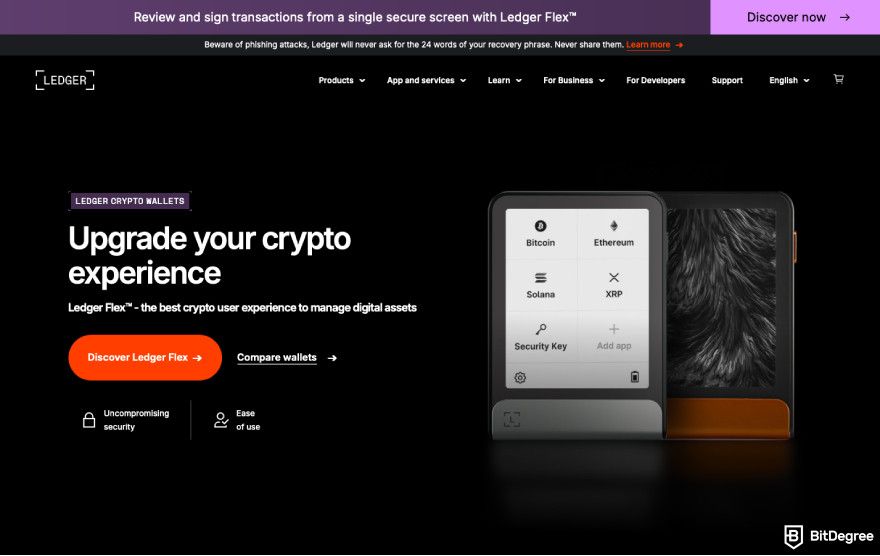
Ledger Flex features an improved touch display with 16 scales of gray and a secure lock screen, a lightweight and compact body with 2 color choices, up to 10 hours of battery life, enhanced security features, and integration with the Ledger Live ecosystem that gives users unlimited access to the world of Web3 and its thousands of dApps, as well as various built-in crypto trading functionalities like buying, swapping, and staking.
Some of those features are shared across the whole Ledger line-up, while others are unique to this particular model. That’s why this Ledger Flex review also features a thorough comparison section at the end.
Latest Ledger Nano X Coupon Found:For a limited time only, get Top-rated Ledger bundles for yourself and your loved ones with a 10% Ledger discount code. Take advantage of this valuable Ledger deal NOW!
Ledger Flex Review: PROS
Now that you’ve got a clue where this wallet comes from, it’s time for an in-depth look at all of its features and specifications. What are the things that users in other Ledger Flex reviews loved the most – and which ones fell into the thumbs-down territory instead?
Let’s start with the standout aspects first.
Top-Notch User Experience
To users more accustomed to apps and web-based platforms, the idea of a hardware wallet might seem a bit intimidating at first – which is why it’s crucial to design a product with an intuitive interface and user-friendly experience. If most user Ledger Flex reviews are any indication, this wallet has passed this bar with flying colors.
Screen
Ledger Flex features a 2.84-inch 16-greyscale touchscreen. Due to its size and E-Ink technology, it won’t exactly feel or function like a smartphone screen, but its high build quality and minimalist software interface make it a breeze to interact with. You can enable tap sounds for a more immersive experience, as well as notification beeps.

The screen is reinforced with the same Gorilla Glass technology you’ll find in many smartphones today: it's manufactured through a chemical strengthening process involving ion exchange that makes the glass more resistant to shattering from impact.[1] The characteristics of the E-Ink technology, alongside an additional anti-glare coating, make the display much easier to use in direct sunlight – no more squinting at the barely visible screen with a maxed-out brightness setting!
One of the highlight features is the lock screen function that makes the Flex display “the world’s first-ever secure touchscreen”, according to Ledger. Even when the device is off, it displays the lock screen picture of a custom NFT.
Body and Casing
The rest of the Ledger Flex wallet is just as intuitive and well-designed. Its aluminum frame with a plastic back cover makes it both durable and lightweight at 57.5g. Speaking of portability – the battery life of up to 10 hours (or, as Ledger puts it on the official product page, up to 150 transactions) means you won’t have to worry about your wallet dying on you when you’re out and about! The device looks elegant and seamless, with only one strategically placed physical button for turning it on and off.

The cherry on the cake for this whole ensemble is the color choice: you can pick between a regular Ledger Flex with a graphite-colored body and the Ledger Flex BTC Edition sporting a much more distinctive “Bitcoin orange” color palette that will surely appeal to collectors and crypto enthusiasts if other user Ledger Flex reviews are any indication. Either color will go well with the Ledger Flex case called Magnet Folio, which comes in “Business Charcoal” and “Party Aubergine”.
Connectivity and Platform Support
Another perk mentioned by many other Ledger Flex reviews is its multi-device connectivity and platform compatibility. Flex is compatible with more than 50 other wallets. What’s more, it has not only mobile apps for iOS and Androids but desktop apps for macOS, Windows, and Linux, too – such extensive desktop support is a rare sight these days and definitely earns this wallet a few extra bonus points.
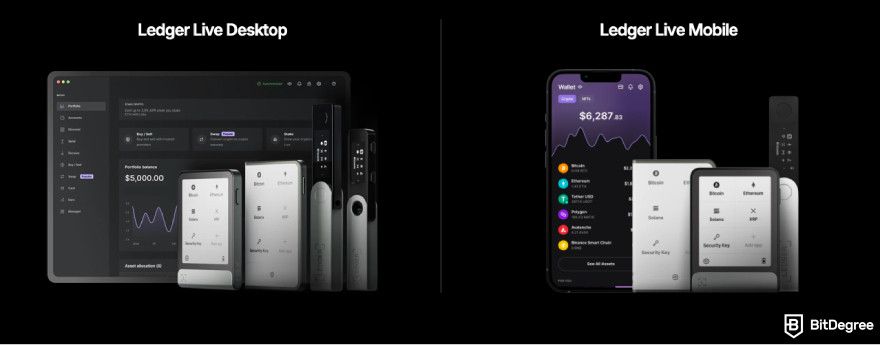
Ledger Flex comes with several types of connections: a USB-C port for charging, Bluetooth 5.2 for connecting with Ledger Live, and NFC (Near Field Communication) for quick and secure contactless transactions.
One of the Most Secure Hardware Wallets
Among the main characteristics crypto traders tend to look for in a hardware wallet is robust security – after all, this is the number one benefit of storing your assets offline instead of keeping them in a software wallet that doesn’t require you to shell out any extra money. The most popular Ledger wallets, such as Nano X and Nano S Plus, have already stood the test of time when it comes to reliability and security; if its specifications are anything to go by, Flex is expected to follow suit.
Ledger Flex is designed with top-notch security in mind from the very core. It’s powered by a Secure Element microprocessor chip with a CC EAL6+ certification – one of the highest ratings showing that the product has undergone rigorous testing to ensure maximum security. The Ledger OS itself provides an additional layer of protection: it isolates different applications from each other so that even if one app gets compromised, the rest of the system remains unaffected.
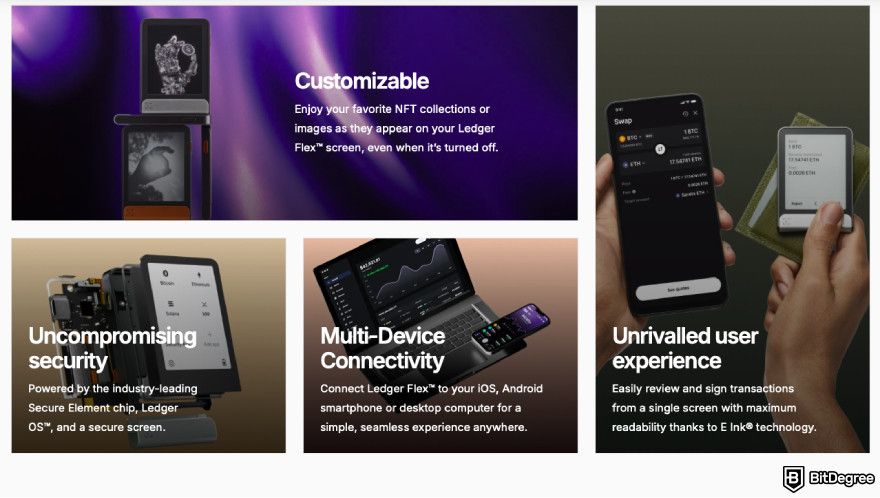
Unlike software wallets, Flex stores your private keys offline. As it has no WiFi connection, this wallet can’t easily be hacked into or otherwise breached or tampered with remotely, making it one of the most fail-proof crypto storage solutions out there. Nevertheless, Ledger doesn’t take any chances: Flex is equipped with an additional safeguard called "Protection Mode” which automatically locks the device as soon as it detects a potential security threat.
The lock screen feature I mentioned earlier in this Ledger Flex review plays a role, as well: it doesn’t just give you something nice to look at but also ensures that no one can see your display in public.
When it comes to security at the software level, Ledger Flex comes with the full package of standard protection mechanisms expected of high-end hardware wallets these days: two-factor authentication (2FA), 24-word Secret Recovery Phrase, MultiSig functionality, and a PIN code. The latter comes in handy if your device gets stolen: entering the wrong PIN three times in a row resets the wallet to factory settings.
Another benefit you get by choosing this wallet is access to the extensive Ledger ecosystem. For instance, the Ledger Live companion app shows the full details of your upcoming transaction in human-readable form so that you won’t have to wonder what exactly is going on there; no more newbie mistakes!

On top of that, you can enhance the security of your Ledger Flex with two additional apps:
- Ledger Security Key: This companion app lets you use your Flex to log into your favorite accounts. It works with Binance, Kraken, Google, and X (formerly Twitter).
- Ledger Recover: A subscription-based service that allows you to create a backup of your wallet access if you lose your device or your seed phrase.
Aside from Ledger Flex, Security Key and Ledger Recover both work with all the other Ledger wallets.
Latest Ledger Nano X Coupon Found:For a limited time only, get Top-rated Ledger bundles for yourself and your loved ones with a 10% Ledger discount code. Take advantage of this valuable Ledger deal NOW!
Thousands of Supported Cryptocurrencies
Even though the main advertised focus of a hardware wallet is safe offline crypto storage, the reality is that most users these days expect far more. A hardware crypto wallet simply wouldn’t be considered a good value for money if it only functioned as an analog vault. That’s why most Ledger Flex reviews from other users highlight its crypto trading and Web3 functionalities.
Even though Ledger Flex has a moderately-sized touch display through which you can access some of its basic features, the lion’s share of its potential comes from the Ledger Live app. Ledger Live is best described as a “one-stop shop for all your crypto needs”. It’s the main way you’re going to interact with your wallet and massively expand its capabilities.

The Ledger Live app on your smartphone provides a superior interface to manage your assets. You can see your entire portfolio and keep track of your balance, as well as buy, swap, lend, borrow, or stake crypto directly on the app without having to use a crypto exchange platform.
Ledger Live features over 500 coins and tokens and Polygon-based NFTs. Some of the Ledger Flex-supported coins are:
However, this is just the tip of the iceberg. Connecting a third-party wallet will give you access to over 15,000 assets, dApps, and NFTs on numerous blockchains. You can find a searchable list on the App Catalog within the Discover tab.
In case you’re wondering if such a plethora of assets and dApps would deplete your wallet’s storage space too quickly – let me assuage that worry for you! Ledger Flex memory size is 1.5 MB, which is enough for up to 100 apps. This should be plenty even for heavy users.

Did you know?
All Crypto wallets may look similar to you but they're NOT all the same!
Ledger Flex Review: CONS
Now that I’ve examined the wallet’s strong suits, it’s time to turn a new page on this Ledger Flex review and give just as much attention to its drawbacks, as well. After all, no device can be absolutely perfect and flawless in every way. Where does Ledger Flex fall short?
No Wireless Charging
While some still consider it more of a gimmick than a necessity, wireless charging has been catching on recently. A lot of companies now include this feature in their high-end or even mid-tier products to add some extra oomph to the specifications list. If anything else, it’s an excellent way to increase the device’s durability and waterproofness.
Unfortunately, Ledger Flex comes without this functionality. The only way to charge your Flex is through a USB-C cable, which would somewhat reduce the wallet’s portability if you had to carry the cable with you rather than using one of the Qi charging stations that are increasingly available in public spaces.

On the upside, Flex’s long battery life renders this shortcoming much less of an issue – with up to 10 hours of battery life with normal use (confirmed by many other Ledger Flex reviews to be an accurate estimate), you’re unlikely to find yourself hard-pressed for a quick charge on the go, anyway!
High Cost Barrier
All of the abovementioned features and specifications, alongside the overwhelmingly positive feedback by other user Ledger Flex reviews, clearly point to this wallet being a top-tier product. Everything from its physical design to user interface and security features adds up to a high-powered package that should satisfy even the most demanding crypto enthusiasts.
Inevitably, this comes with a catch: premium products tend to come with premium pricing, too, and this wallet is no exception. The Ledger Flex price point of $249 might just be too much of an upfront investment for many prospective buyers, particularly beginners and inexperienced traders who might find it difficult to justify the price if they know they won’t be making the most out of the wallet’s extensive feature list.
Here’s what’s included in the box:
- Ledger Flex;
- USB-C to USB-C charging cable;
- 1 recovery sheet;
- Ledger Flex guide.
If you want some extra protection (or a nice accessory), the Ledger Flex case (Magnet Folio or the plastic Protective Case) will cost you an additional $29 or $39, respectively.
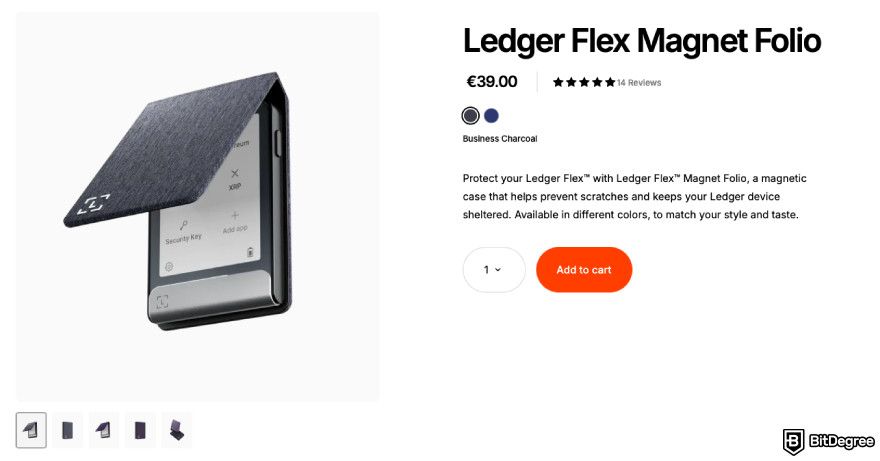
You can also pick up the Ledger Flex + 1 year of Ledger Recover bundle for $348.99 and save 2 months of the subscription fee.
As usual, try to resist the temptation of buying Ledger Flex from unofficial resellers or secondhand sellers! With something as data-sensitive as crypto hardware wallets, you really want to ensure that you’re getting your device from the most reliable first-hand source. Some user Ledger Flex reviews have mentioned issues with receiving a faulty device from unreliable sellers. I recommend buying directly from the official Ledger website.
Alternatives
If you’re trying to choose a new hardware crypto wallet, it’s important to consider all your options from every angle. And there are quite a few to wade through! Which is why my Ledger Flex review comes with a bonus section where I will compare this wallet with some of the most competitive alternatives in terms of features and pricing.
The Ledger line-up alone has so much to offer. Which model would come out on top in the fight of Ledger Flex VS Nano X, for instance? Or Ledger Flex VS Stax, another recent addition? Let’s get straight to the facts and find out!
Ledger Flex VS Ledger Stax
Ledger Stax is another high-tier flagship in Ledger’s collection of hardware crypto wallets. Released just a few months before Flex, it features an even more advanced set of specifications. The side-by-side comparison of Ledger Flex VS Stax reveals quite a heated battle. Let’s see how these two wallets stack up against each other.
The number one standout feature of Stax is its display. At 3.7 inches, it’s the biggest screen on any Ledger hardware wallet to date. Unlike the screen on Flex, this one has curved corners and stretches out edge-to-edge, resembling a smartphone. Other than size and shape, the remaining screen qualities are the same in both models: 16 greyscale and E-Ink technology. Ledger Stax sports the same lock screen feature as Flex.
While Ledger Flex is described as “credit card-sized”, Stax is a bit shorter and broader, ever-so-slightly thicker, and a tad heavier – but the differences are barely significant enough to notice. They’re both constructed of an aluminum frame and a plastic back cover. Unlike Flex, Ledger Stax comes with a complementary Magnetic Shell case included in the box.
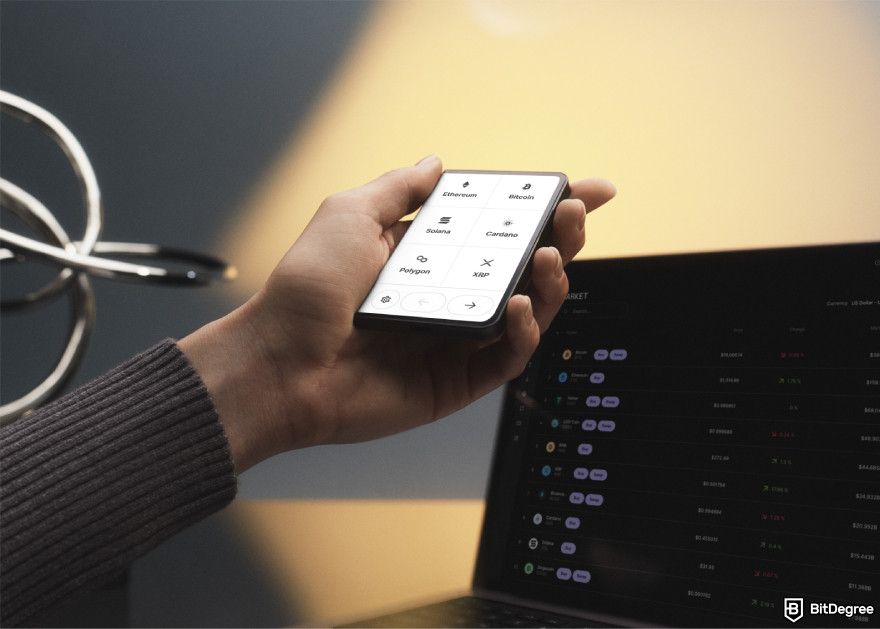
Unfortunately, it’s only available in gray. But what it lacks in color choice, it makes up for with another neat detail – a magnetized back that lets you stack several devices on top of each other. If you’re one of those crypto traders who like keeping all of their eggs in separate baskets – now you can realize this preference in the most literal sense by owning several Stax wallets without worrying how to store them together!
Stax’s battery life is just as impressive: up to 10 hours or several days on standby status. What’s more, it’s equipped with the wireless Qi charging option missing on Flex.
When it comes to security, Ledger Stax doesn’t offer anything new compared to Flex. It comes with the same Secure Element chip, CC EAL6+, a 24-word Secret Recovery Phrase, and other basic security measures. The Ledger Flex memory size is the same as Stax – 1.5 MB.
Its biggest drawback is the price: at $399, Ledger Stax is easily one of the most expensive hardware wallets on the market right now, and well out of range for many people’s budget. Ledger Flex, priced $249, looks a bit more affordable in comparison.
Ledger Flex VS Ledger Nano X
Let’s consider another Ledger wallet. When it comes to the features and benefits of Ledger Flex VS Nano X, are they enough to give the former wallet the decisive edge – or would you be better off with its older alternative?
Ledger Nano X doesn’t seem to have much in common with Flex visually at first glance. It sports a long and narrow shape accentuated by a type of screen very different from the one on Flex. The Ledger Nano X display is only 1.09-inches. Rather than an E-Ink screen, it’s an OLED display. It looks much more vibrant than Flex’s paper-like E-Ink touch screen[2] but isn’t quite as energy efficient. Due to this and the much smaller size, Nano X only lasts up to 8 hours, and an additional 3-4 hours on standby mode.
Having said that, the design of Nano X is more memorable and eye-catching to some degree. The device looks closer to a retro MP3 player or a fancy USB flash than a tiny smartphone. It comes in a whole palette of six different colors. Most of its body is plastic, except for the stainless steel swivel. At 34g, this wallet is almost half the weight of Flex.
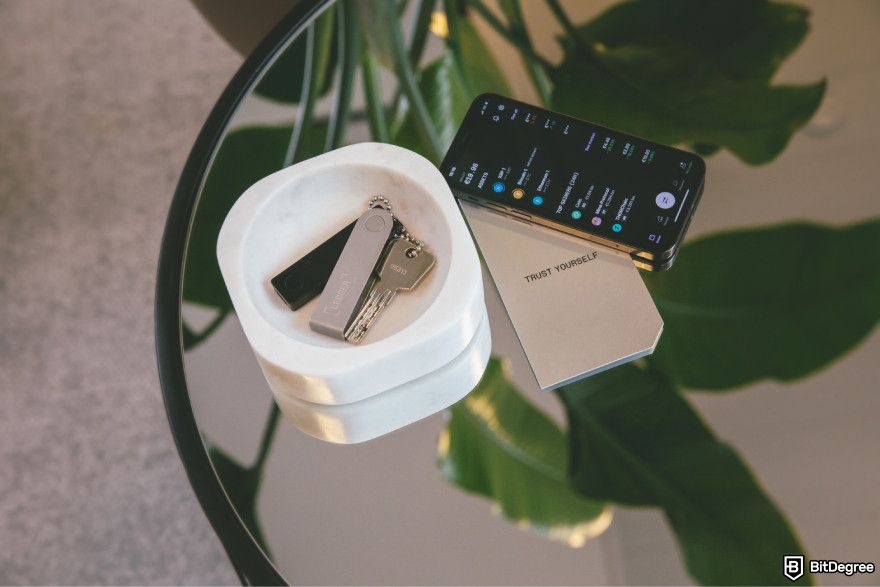
Unlike Ledger Flex, Nano X lacks the NFC connectivity option. Aside from that, all the other platform compatibility and connectivity aspects are the same. Nano X slightly edges out Ledger Flex in the storage area: the Ledger Flex storage capacity is 1.5 MB, whereas Ledger Nano X has 2 MB of memory space, although this difference probably won’t amount to much under real-use conditions.
When it comes to security, Ledger Nano X is a step below Flex due to a lower CC EAL rating of 5+. On the other hand, it features an additional ANSSI CSPN certification which Flex doesn’t have. The remaining security measures on both devices are identical: a 24-word Secret Recovery Phrase, a 4 to 8-digit PIN code, and Ledger OS.
Speaking of software – the Ledger ecosystem doesn’t only come with Ledger Flex. Security Key and Ledger Recover are both available for Nano X, too.
The one aspect where Ledger Nano X undeniably wins out is the cost: at only $149, it’s one of the more affordable models in the Ledger line-up. The package includes the same basic accessories as the one Flex comes with, plus a keychain strap – a nice little detail that’s received some appreciation in other Ledfer Flex reviews, too.
How to Set Up Ledger Flex?
This is where my Ledger Flex review gets practical! I’ve told you all about this wallet’s strengths and shortcomings and how it measures up against the leading alternatives – it’s about time you learned how to use Ledger Flex!
Whether you’ve just unboxed your brand-new device and need a few pointers or are still mulling over your options, this Ledger Flex setup guide is as good an ending point as any.
Here’s the list of steps to follow; it might seem lengthy at first glance, but the process itself is quite simple and straightforward.
Step 1: Press and hold the right-side button to turn your Ledger Flex on, then tap on “Continue”.
Step 2: Tap on “Ledger Live Mobile”.
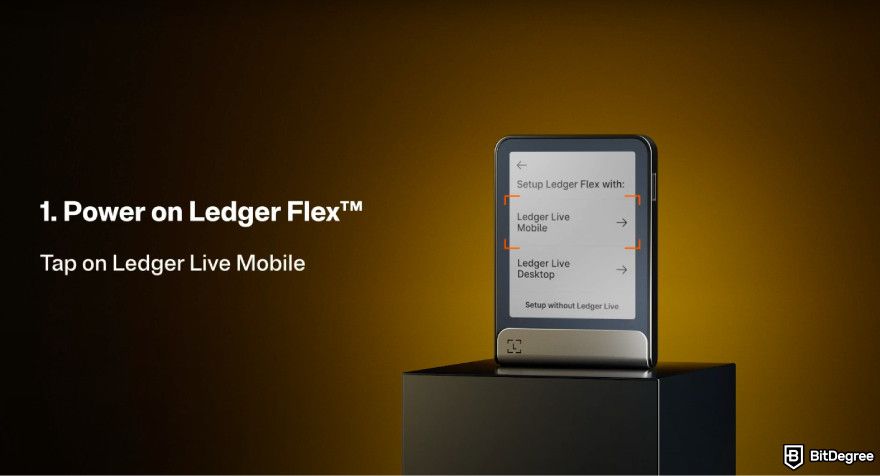
Step 3: Scan the QR code to open or download the Ledger Live app.
Step 4: Tap on “Get Started”.
Step 5: Tap on “Set up your Ledger”.
Step 6: Select Ledger Flex from the list.
Step 7: Wait for the pairing codes to appear, then tap on “Yes, it matches” if both codes are the same.
Step 8: Tap on “Check Ledger Flex.”
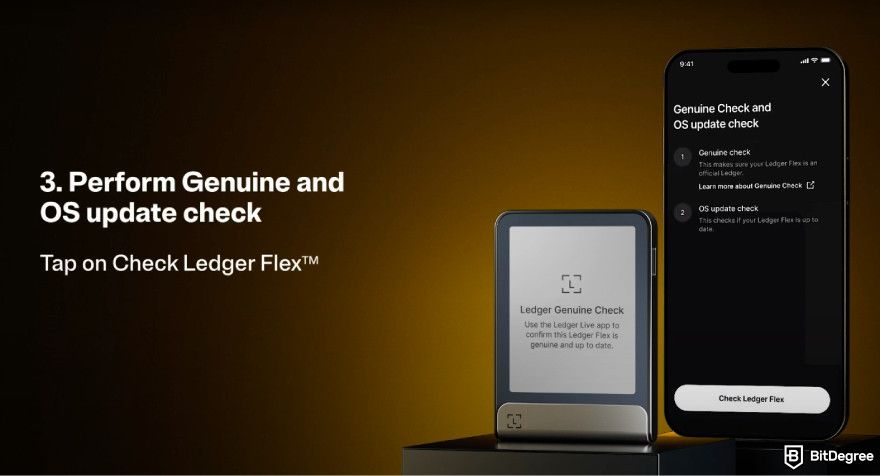
Step 9: Tap on “Allow”, then “Continue to setup”.
Step 10: Give your Ledger Flex a unique name: enter it using the touchscreen keyboard, then click “Confirm”.
Step 11: Choose your PIN of 4 to 8 digits, then tap ✔️ to confirm it.
Step 12: Re-enter your PIN.
Step 13: Tap “Continue”, then “Set it up as a new Ledger”.
Step 14: Take your Recovery Sheet and write down the 24 words (they will appear in groups of 4 on the screen), then tap on “Done”.
Step 15: Tap on “Start confirmation”.
Step 16: Select the requested words from the 24-word Recovery Phrase you’ve just created.
Step 17: Go to Ledger Live and select how you want to backup your Secret Recovery Phrase.
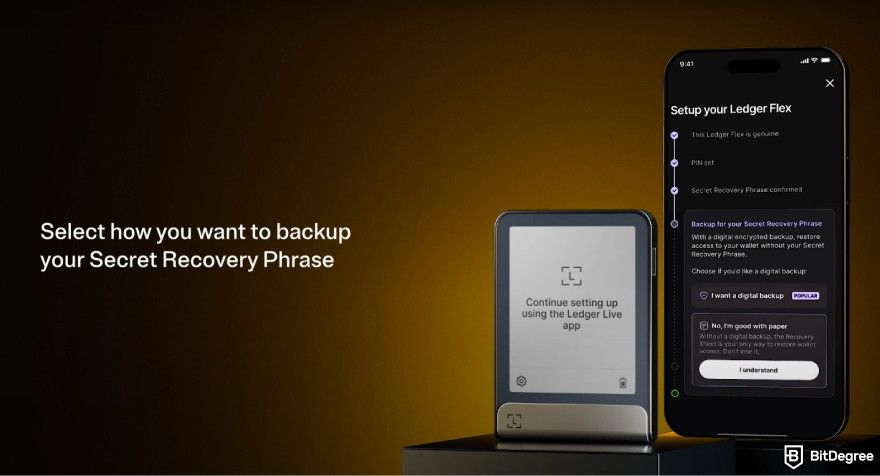
Step 18: After completing your Ledger Flex setup, you can install apps on your device.
That’s it! You’re now ready to go. If you need some more guidance on how to use Ledger Flex, feel free to refer to the user manual you can find on the official Ledger website or its paperback version included in the box with your device.
Conclusions
Hopefully, my Ledger Flex review gave you a comprehensive picture of this wallet’s strengths and weaknesses. Let’s wrap it up with a little recap. Ledger Flex is a hardware crypto wallet equipped with a medium-sized E-Ink touchscreen. It features a user-friendly interface, Bluetooth and NFC connection, and integration with 15,000+ coins and NFTs through Ledger Live and third-party dApps.
Ledger Flex is a great choice for users who need portability, since the device is lightweight and has a battery life of up to 10 hours, and the lock screen function protects your privacy in public. Unfortunately, it’s missing the wireless Qi charging option which is now common in premium devices.
Compared to the popular alternatives, Ledger Flex can certainly hold its ground when it comes to most of the relevant features. It has a much bigger screen than Nano X or Safe 5 but loses out when it comes to pricing: at $249, it’s the second most expensive Ledger wallet in their current line-up, which probably limits its target audience to hardcore crypto enthusiasts looking for an advanced premium product.
The content published on this website is not aimed to give any kind of financial, investment, trading, or any other form of advice. BitDegree.org does not endorse or suggest you to buy, sell or hold any kind of cryptocurrency. Before making financial investment decisions, do consult your financial advisor.
Scientific References
1. S. Ahsan, I. B. Sohn 2, and H. K. Choi: 'Gorilla Glass Cutting Using Femtosecond Laser Pulse Filaments'
2. E. Siegenthaler, L. Schmid, M. Wyss, et al.: 'LCD vs. E-ink: An Analysis of the Reading Behavior'.





